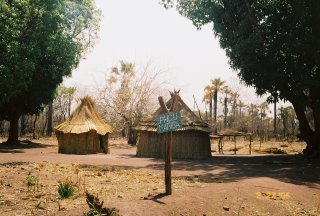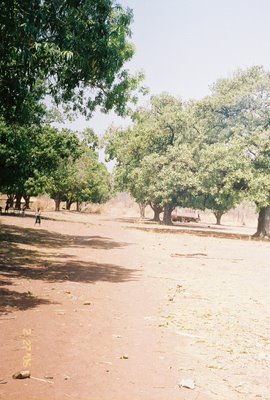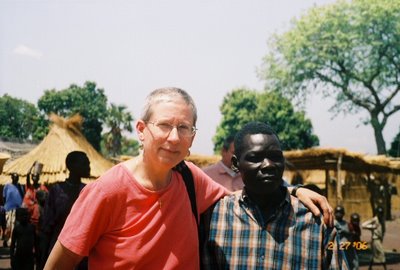
We arrived in Nideh and visited with them briefly. But the Bishop wanted us to drive to Mariba, so we took a hasty departure.
I wasn’t entirely clear on why the Bishop took us away from Nideh so quickly to visit Mariba.
The sign when we entered Mariba (pictured above) also designates it “PHCU." That stands for Primary Health Care Unit. This means this is one of the Samaritan’s Purse hospital’s outlying units – a place where people can receive basic medical attention.
 I’ve tried to talk about how primitive the roads are. Perhaps this shot will help. This is the road leading into Mariba. Can’t see a road? Maybe that’s because the “roads” are barely discernible. The opening between the trees here (just left of center) is what passes for a road.
I’ve tried to talk about how primitive the roads are. Perhaps this shot will help. This is the road leading into Mariba. Can’t see a road? Maybe that’s because the “roads” are barely discernible. The opening between the trees here (just left of center) is what passes for a road.When we arrived in Mariba, we quickly saw that there were virtually no “permanent” structures in the village – that is, none of the “mud” buildings we had in Lui. Every structure in Mariba was a newly-built one made of grass bundles, like these.
 This reminded me of the earlier comments I had heard. People build of grass when they have little faith in the peace; they build in mud and brick when they believe the peace will hold. Moreover, they build of grass when they don’t fear they may have to run for their lives from attackers. As somebody said, in a grass hut you can flee in any direction, but you only have one door from a mud hut.
This reminded me of the earlier comments I had heard. People build of grass when they have little faith in the peace; they build in mud and brick when they believe the peace will hold. Moreover, they build of grass when they don’t fear they may have to run for their lives from attackers. As somebody said, in a grass hut you can flee in any direction, but you only have one door from a mud hut. Here several of our group view one of the burned-out tukals. To my ignorant eyes, this “merely” looked like the site of a tragic fire. But as Bishop Bullen walked us around the village, he explained what had happened. These people had been burned-out of their village. The Dinka people had come in, destroying the homes of the Moru. The Moru had seen family members – those not fast enough to run into the bush -- hacked to death. They had lost everything they owned: cooking utensils, clothing, agricultural implements, you name it! I think this is where it hit me – how the people of Lui had lost everything.
Here several of our group view one of the burned-out tukals. To my ignorant eyes, this “merely” looked like the site of a tragic fire. But as Bishop Bullen walked us around the village, he explained what had happened. These people had been burned-out of their village. The Dinka people had come in, destroying the homes of the Moru. The Moru had seen family members – those not fast enough to run into the bush -- hacked to death. They had lost everything they owned: cooking utensils, clothing, agricultural implements, you name it! I think this is where it hit me – how the people of Lui had lost everything.I don’t know about other people. But as I walked around the village, I was increasingly appalled by how this travesty could have been done. It was beyond breath-taking.
After we had walked around the village, we settled into a formal greeting. But there was no structure in which we could meet -- no nice, cool payut in which we could gather. There were no basins in which women could bring us cool water to wash our hands. There was no food that they could give us. There was only a tree, in the shade of which we gathered and listened to them sing. And we prayed. And some of us cried. What else could we do??
This is the priest who remains in the village: Pastor January.

As we moved away from the village and toward our truck, I saw Archdeacon Robert talking with Bishop Bullen, then he handed some money to Father January, so he could buy food in the Lui market for his parishioners. It was the most we could do in that brief visit, and it felt so meager. And yet I bet the rest of the group was praying, as I was, that God would multiply it and use it to sustain them through the long coming weeks.
Piling back into our Jeep at the end of that brief visit, it hit home for me. I was going to return to my comfortable life in the U.S. after a few uncomfortable days in Lui. These people were left there to eek out a living after being attacked by “fellow Christians.” Whatever “deprivations” I thought I had suffered in Lui to that point, I think that’s the moment where God put all of them into perspective for me.




No comments:
Post a Comment